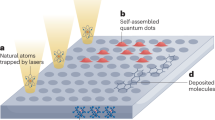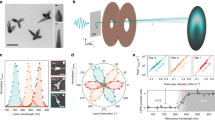Abstract
Nanophotonics is based on the ability to construct structures with specific spatial distributions of the refractive index. Conventional nanophotonic structures are fabricated in planar settings, similar to electronic integrated circuits. We present a new class of nanophotonic structures with intricate design in three dimensions inspired by general relativity concepts, where the evolution of light is controlled through the space curvature of the medium. We demonstrate this concept by studying the evolution of light in a paraboloid structure inspired by the Schwarzschild metric describing the space surrounding a massive black hole. Our construction allows control over the trajectories, the diffraction properties and the phase and group velocities of wavepackets propagating within the curved-space structure. Finally, our structure exhibits tunnelling through an electromagnetic bottleneck by transforming guided modes into radiation modes and back. This generic concept can serve as the basis for curved nanophotonics and can be employed in integrated photonic circuits.
This is a preview of subscription content, access via your institution
Access options
Access Nature and 54 other Nature Portfolio journals
Get Nature+, our best-value online-access subscription
$29.99 / 30 days
cancel any time
Subscribe to this journal
Receive 12 print issues and online access
$209.00 per year
only $17.42 per issue
Buy this article
- Purchase on Springer Link
- Instant access to full article PDF
Prices may be subject to local taxes which are calculated during checkout




Similar content being viewed by others
References
Laundau, L. D. & Lifshitz, E. M. The Classical Theory Of Fields (Butterworth-Heinemann, Oxford, 1975).
Leonhardt, U. & Philbin, T. G. General relativity in electrical engineering. New J. Phys. 8, 247 (2006).
Cai, W. & Shalaev, V. Optical Metamaterials Fundamentals and Applications (Springer, New York, 2010).
Grbic, A. & Eleftheriades, G. V. Overcoming the diffraction limit with a planar left-handed transmission-line lens. Phys. Rev. Lett. 92, 117403 (2004).
Schurig, D. et al. Metamaterial electromagnetic cloak at microwave frequencies. Science 314, 977–980 (2006).
Alù, A. & Engheta, N. Multifrequency optical invisibility cloak with layered plasmonic shells. Phys. Rev. Lett. 100, 113901 (2008).
Ergin, T., Stenger, N., Brenner, P., Pendry, J. B. & Wegener, M. Three-dimensional invisibility cloak at optical wavelengths. Science 328, 337–339 (2010).
Chen, X. et al. Macroscopic invisibility cloaking of visible light. Nat. Commun. 2, 176 (2011).
Shalaev, V. M. Optical negative-index metamaterials. Nat. Photon. 1, 41–48 (2007).
Alù, A., Silveirinha, M. G., Salandrino, A. & Engheta, N. Epsilon-near-zero metamaterials and electromagnetic sources: tailoring the radiation phase pattern. Phys. Rev. B 75, 155410 (2007).
Silveirinha, M. & Engheta, N. Design of matched zero-index metamaterials using nonmagnetic inclusions in epsilon-near-zero media. Phys. Rev. B 75, 075119 (2007).
Edwards, B., Alù, A., Young, M. E., Silveirinha, M. & Engheta, N. Experimental verification of epsilon-near-zero metamaterial coupling and energy squeezing using a microwave waveguide. Phys. Rev. Lett. 100, 033903 (2008).
Naik, G. V., Shalaev, V. M. & Boltasseva, A. Alternative plasmonic materials: beyond gold and silver. Adv. Mater. 25, 3264–3294 (2013).
Smolyaninov, I. I., Smolyaninova, V. N., Kildishev, A. V. & Shalaev, V. M. Anisotropic metamaterials emulated by tapered waveguides: application to optical cloaking. Phys. Rev. Lett. 102, 213901 (2009).
Batz, S. & Peschel, U. Linear and nonlinear optics in curved space. Phys. Rev. A 78, 043821 (2008).
Schultheiss, V. H. et al. Optics in curved space. Phys. Rev. Lett. 105, 143901 (2010).
Bekenstein, R., Nemirovsky, J., Kaminer, I. & Segev, M. Shape-preserving accelerating electromagnetic wave packets in curved space. Phys. Rev. X 4, 011038 (2014).
Genov, D. A., Zhang, S. & Zhang, X. Mimicking celestial mechanics in metamaterials. Nat. Phys. 5, 687–692 (2009).
Narimanov, E. E. & Kildishev, A. V. Optical black hole: broadband omnidirectional light absorber. Appl. Phys. Lett. 95, 041106 (2009).
Chen, H., Miao, R.-X. & Li, M. Transformation optics that mimics the system outside a Schwarzschild black hole. Opt. Express 18, 15183–15188 (2010).
Fernández-Núñez, I. & Bulashenko, O. Anisotropic metamaterial as an analogue of a black hole. Phys. Lett. A 380, 1–8 (2016).
Philbin, T. G. et al. Fiber-optical analog of the event horizon. Science 319, 1367–1370 (2008).
Belgiorno, F. et al. Hawking radiation from ultrashort laser pulse filaments. Phys. Rev. Lett. 105, 203901 (2010).
Barceló, C., Liberati, S. & Visser, M. Analogue gravity. Living Reviews in Relativity 14, 3 (2011).
Demircan, A., Amiranashvili, Sh. & Steinmeyer, G. Controlling light by light with an optical event horizon. Phys. Rev. Lett. 106, 163901 (2011).
Sheng, C., Liu, H., Wang, Y., Zhu, S. N. & Genov, D. A. Trapping light by mimicking gravitational lensing. Nat. Photon. 7, 902–906 (2013).
Karen, E. et al. Nonlinear optics of fibre event horizons. Nat. Commun. 5, 4969 (2014).
Wang, S. F. et al. Optical event horizons from the collision of a soliton and its own dispersive wave. Phys. Rev. A 92, 023837 (2015).
Bekenstein, R., Schley, R., Mutzafi, M., Rotschild, C. & Segev, M. Optical simulations of gravitational effects in the Newton–Schrödinger system. Nat. Phys. 11, 872–878 (2015).
Bekenstein, R. et al. Curved space nanophotonics inspired by general relativity. In Conference on Lasers and Electro-Optics paper FW1D.2 (Optical Society of America, 2016).
Kabessa, Y. et al. Nanophotonic structures constructed in a curved space inspired by general relativity concepts. In Advanced Photonics paper ITu1A.7 (Optical Society of America, 2016).
Kawata, S., Sun, H.-B., Tanaka, T. & Takada, K. Finer features for functional microdevices. Nature 412, 697–698 (2001).
Maruo, S., Nakamura, O. & Kawata, S. Three-dimensional microfabrication with two-photon-absorbed photopolymerization. Opt. Lett. 22, 132–134 (1997).
Aoki, T. et al. Observation of strong coupling between one atom and a monolithic microresonator. Nature 443, 671–674 (2006).
Dayan, B. et al. A photon turnstile dynamically regulated by one atom. Science 319, 1062–1065 (2008).
Shomroni, I. et al. All-optical routing of single photons by a one-atom switch controlled by a single photon. Science 345, 903–906 (2014).
Acknowledgements
This research was supported by the Israeli Ministry of Science and Technology and by the US Air Force Office of Scientific Research. R.B. acknowledges support from the Adams Fellowship Program of the Israel Academy of Sciences and Humanities and the support of the National Science Foundation through a grant to ITAMP. Y.K. and A.J.A. thank Y. Garcia at the Brojde Center for Innovative Engineering and Computer Science for advice and assistance in using the Nanoscribe system.
Author information
Authors and Affiliations
Contributions
All authors contributed significantly to this work.
Corresponding authors
Ethics declarations
Competing interests
The authors declare no competing financial interests.
Additional information
Publisher’s note: Springer Nature remains neutral with regard to jurisdictional claims in published maps and institutional affiliations.
Electronic supplementary material
Supplementary Information
Supplementary Information
Supplementary Video
Supplementary Video
Rights and permissions
About this article
Cite this article
Bekenstein, R., Kabessa, Y., Sharabi, Y. et al. Control of light by curved space in nanophotonic structures. Nature Photon 11, 664–670 (2017). https://doi.org/10.1038/s41566-017-0008-0
Received:
Accepted:
Published:
Issue Date:
DOI: https://doi.org/10.1038/s41566-017-0008-0
This article is cited by
-
Curving the space by non-Hermiticity
Nature Communications (2022)
-
Optical analogues to the equatorial Kerr–Newman black hole
Communications Physics (2020)
-
Hyperbolic lattices in circuit quantum electrodynamics
Nature (2019)
-
Definite photon deflections of topological defects in metasurfaces and symmetry-breaking phase transitions with material loss
Nature Communications (2018)



